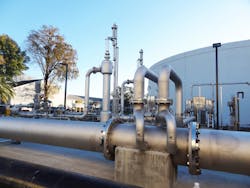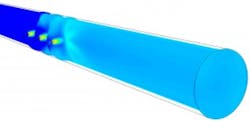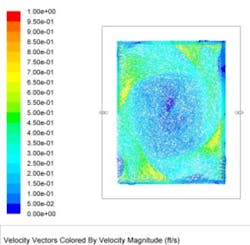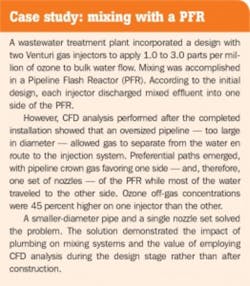Computational fluid dynamics (CFD) is a powerful tool for designing mixing systems and is especially useful for modeling multiphase flows. As interest grows in direct ozonation/aeration, and water dischargers scramble to meet rigorous water quality standards set by regulatory agencies, ensuring proper mixing and reliable measurement has become paramount for many companies and utilities. Applied early in the system design process, CFD analysis helps meet treatment challenges — whether those include ensuring optimum flow, reducing the costs associated with extra pumping or cavitation that can result from turbulence, building efficient retrofit systems, or pinpointing the optimum location for measurement sensors to control supervisory control and data acquisition (SCADA) systems.
CFD modeling provides valuable insight, not just into the components of a water treatment operation, but also into the system as a whole. In short, CFD does not only help visualize flow and turbulence, but it also guides us into thinking beyond individual devices to see any given treatment problem from a system’s point of view.
Multiphase models
Advances in CFD modeling are removing limitations in understanding multiphase flows. Standard hydraulic calculations focus predominantly on lumped parameters, such as head loss, for a single phase, such as water. The results can significantly misrepresent the behavior of gas/water mixtures, also called multiphase flows, leading to poor mixing and inadequate mass transfer. The use of multiphase CFD models and real-world experience in mixing and mass transfer helped a company develop highly effective oxygenation and ozonation systems for retrofits or new construction.
CFD is at the intersection of fluid mechanics, computer science and numerical analysis. It combines engineering physics, chemistry and math to address realistic fluid flow challenges and provides a detailed insight into what is happening in the system. Trying to model multiphase flows with calculations that were designed to model only the behavior of water can lead to unwanted and sometimes catastrophic problems.
CFD software allows for the optimum positioning and protrusion of nozzles to maximize gas transfer in a PFR.
End users cannot use single phase approaches blindly to tackle multiphase problems. Semi-empirical, back-of-the-envelope calculations, while useful for initial, basic estimations, do not complete the job because they do not account for realistic flows. They include broad assumptions, particularly of ideal flows and plug flow, which may not be applicable to certain processes. Designing equipment and systems to handle multiphase flows using these assumptions adds many errors. If the end user or operator needs additional processes downstream, these errors can be multiplied, often with negative results.
Mixing behavior
CFD analysis helps answer many questions that arise in multiphase systems. Some engineers may approach a system purely in terms of hydraulics and head loss. The main question is, "What is the bottom line in regard to energy consumption?"
This way of thinking does not directly correlate to overall treatment targets if gas is added to a system. An end user or system designer has to understand multiphase flow. Energy costs may be met from a purely hydraulic point of view. However, the overall goal of, for example, transferring ozone or oxygen into water to reach disinfection or odor control, might not be met. This in turn will directly add to energy costs from a different perspective — an ozone generator might be overworked.
The speed of mixing in a small space is crucial when examining how bubbles interact with water; how much interaction occurs; how much chemical reaction, such as oxidation, is taking place; and most importantly, if the reaction is continuing to completion. If reactions are incomplete or inadequate, the outcome can produce harmful byproducts.
CFD software helped model the circulation in a wastewater lagoon, optimizing nozzle placement and pump size to maximize aeration.
As a result, finely tuned, multiphase CFD modeling is critical to design ozonation or oxygenation systems in which mass transfer occurs efficiently and thoroughly. Bubble diameter, the density and organic matter content of the liquid, the shape and dimension of the mixing vessel or pipeline, and an array of other variables can dramatically impact whether the target gas-liquid or liquid-liquid mass transfer occurs adequately to achieve the necessary chemical reactions.
Optimum installation and operation of a sidestream Venturi injection system provides a sustainable ozone transfer efficiency of greater than 90 percent. However, that efficiency can be adversely affected when upstream and downstream piping and hydraulic design permit the uneven gas distribution and the coalescence and migration of gas bubbles.
Problems with insufficient mixing can also endanger the efficiency or even the safety of downstream systems. For instance, accumulations of unmixed gas can interfere with proper system function by creating slugs — pockets of gas that interfere with mass transfer — or preferential flows, in which the liquid stratus flows into one set of valves or pipes and crown gas into another. Turbulence or gas pockets can cause cavitation damage in pumps, while entrained bubbles can coalesce and obstruct filters.
Putting pipelines on track
A gas/water blend in a pipeline was analyzed and redesigned for a client. In one instance, much of the gas separated from the liquid in the space of just 3 diameters of the pipe, creating a stratified flow. In another circumstance, the model showed gas accumulating on the outer edges of the flowing mass — an annular flow — and traveling faster than the liquid in the center.
Pipeline Flash Reactors (PFRs) enhance mixing in a small footprint. PFRs consist of a short spool of flanged pipe with specially designed nozzles arranged to deliver an ozonated or aerated sidestream to be mixed with the bulk flow in the main pipeline in a limited amount of space. The nozzles are fed by Venturi injectors, which use pressurized sidestream flow to draw air, oxygen or ozone into the system. Based on dozens of variables ranging from the velocity of the sidestream flow to the physical dimensions of the system, CFD analysis allows for the optimized placement, size and depth of the nozzles for each PFR. Pipeline mixing is definitely not a one-size-fits-all operation.
CFD analysis also illustrates the importance of well-designed PFRs and the impacts of components of piping that connect them to the rest of the facility. Pipeline length, vertical drops, elbows versus tees and seemingly insignificant pipe angles caused by installation errors can significantly impact the efficiency of even the best components. In short, operators, end users and designers must think in terms of systems and not individual, unconnected components. CFD is a powerful tool to help stakeholders see the interconnected nature of the system.
As with any model, the "garbage in, garbage out" rule applies. Model results are only as good as the data on which they are based. If a CFD analysis is used to troubleshoot or design a system, accurate information is required for the model.
The geometry must be right, especially in retrofitted systems. In a new plant, a CFD team can guide the design process for upstream and downstream plumbing. In an existing plant with limited space, plumbing is already in place. Because of this, the CFD model must help determine how to operate the system in that specified space. With accurate information about the existing plumbing, CFD can optimize the system’s performance by modeling the hydraulics and mixing for the current space.
Several projects have been completed in which CFD modeling fixed existing design flaws, rescued facilities that had been experiencing problems and optimized designs for new facilities. In one case, a PFR replaced outdated bubble diffusers that were not keeping up with the ozone demand required to eliminate high levels of hydrogen sulfide.
With CFD, engineers and designers discover obvious problems and are able to create reasonably straightforward solutions. Instead of building things blindly, a good, careful CFD analysis provides insight and confidence that a design is optimal for the actual physical and chemical processes.
Jim Lauria is vice president of Sales & Marketing for Mazzei Injector Company, a fluid design company that manufactures mixing and contacting systems. He holds a bachelor’s degree in chemical engineering from Manhattan College and has more than 20 years of global water treatment experience in the agricultural, municipal, industrial and commercial markets. Lauria may be reached at [email protected].
Srikanth Pathapati is director of CFD analysis and engineering at Mazzei Injector Company. He holds a bachelor’s degree in electrical engineering from the University of Madras, India, and a Ph.D. in environmental engineering from the University of Florida. With more than a decade of combined academic and industry experience in CFD modeling of multiphase flows across many disciplines, Pathapati heads Mazzei’s CFD team for designing multiphase contacting systems to deliver optimal mixing and mass transfer performance.





